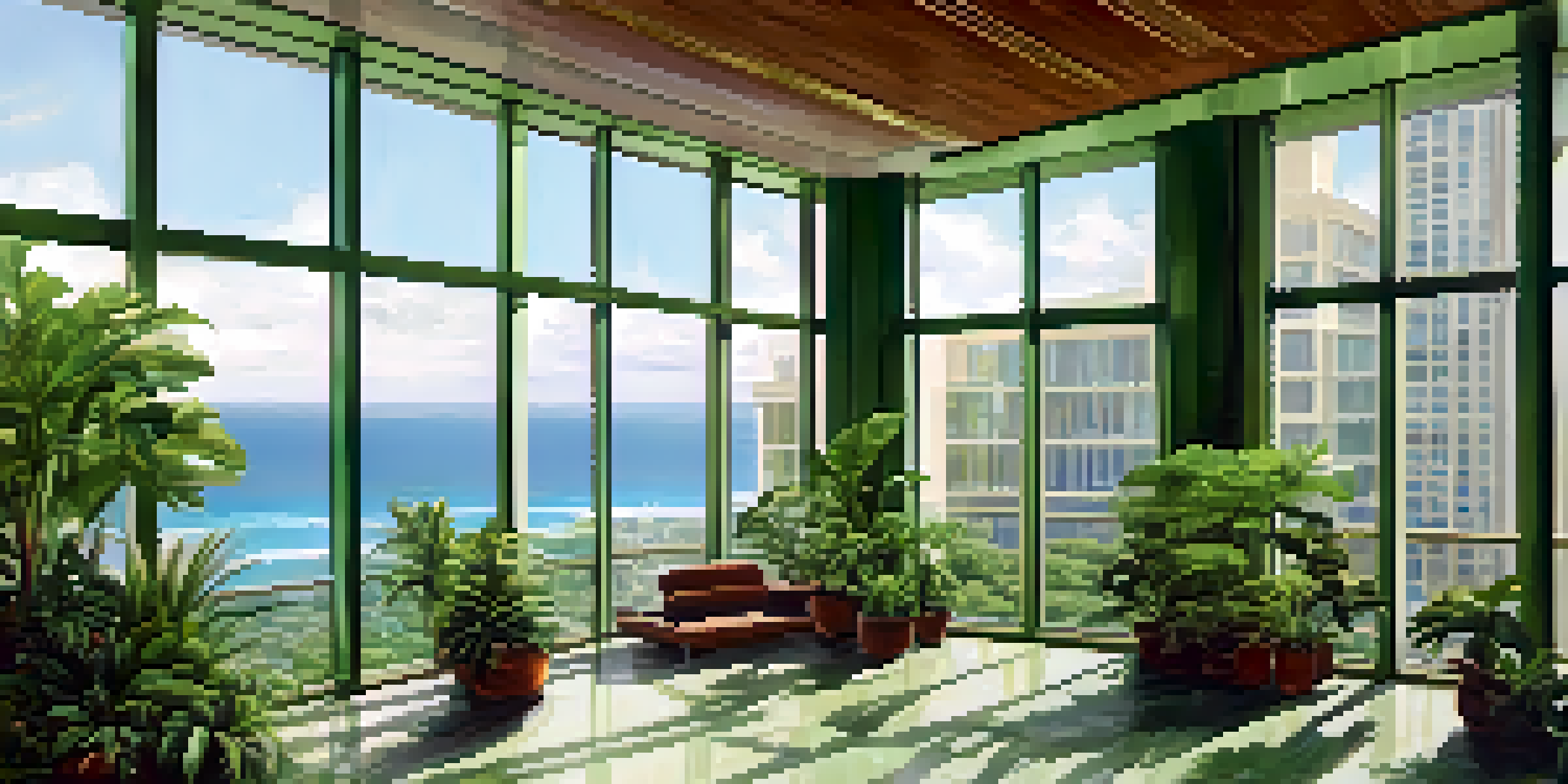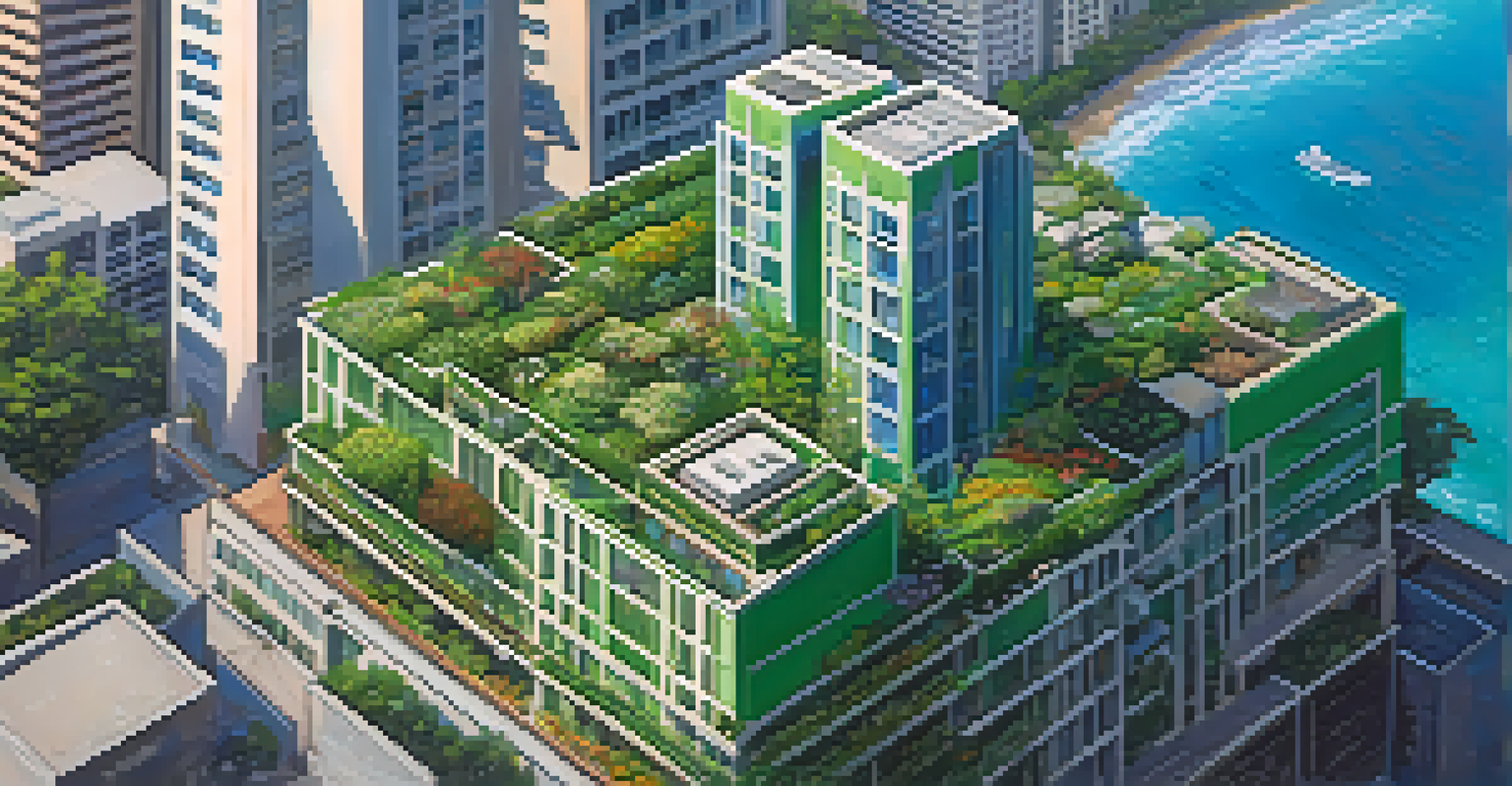Honolulu's Green Skyscrapers: Merging Nature with Innovation

Introduction to Honolulu's Green Skyscrapers
Honolulu is not just a paradise of sun and surf; it's also emerging as a leader in sustainable architecture. The city's green skyscrapers are reshaping its skyline while promoting environmental harmony. These towers are a testament to how innovation can meet nature, creating spaces that are both livable and eco-friendly.
The greatest threat to our planet is the belief that someone else will save it.
As urbanization continues to rise, cities like Honolulu are looking for ways to balance development with sustainability. Green skyscrapers leverage technology and design to minimize environmental impacts while enhancing quality of life. This blend of nature and innovation is essential for creating a resilient urban future.
In this article, we'll explore the fascinating world of Honolulu's green skyscrapers, examining their design features, ecological benefits, and the inspiration behind them. Get ready to see how the city is merging nature with innovation in a way that’s both beautiful and practical.
Defining Green Skyscrapers: What Makes Them Unique?
Green skyscrapers are high-rise buildings designed with sustainability in mind. They often incorporate features like energy-efficient systems, green roofs, and rainwater harvesting. These elements not only reduce the ecological footprint but also enhance the well-being of the occupants.

One unique aspect of these buildings is their use of natural materials and biophilic design principles. This means that they aim to connect people with nature, often through the use of plants, natural light, and open spaces. This approach not only makes the buildings aesthetically pleasing but also promotes mental and physical health.
Sustainable Architecture in Honolulu
Honolulu's green skyscrapers showcase the city's commitment to merging innovative design with environmental sustainability.
In Honolulu, these skyscrapers are often designed to withstand the tropical climate while maximizing energy efficiency. The incorporation of local flora, for instance, not only provides beauty but also helps in cooling the buildings naturally, showcasing a perfect synergy between environment and architecture.
Ecological Benefits of Green Skyscrapers
One of the most significant advantages of green skyscrapers is their positive impact on the environment. By utilizing renewable energy sources, such as solar panels, they significantly reduce greenhouse gas emissions. This shift is crucial for combating climate change, especially in regions vulnerable to its effects.
Sustainability is no longer about doing less harm. It’s about doing more good.
Additionally, green roofs and walls contribute to biodiversity. They offer habitats for various species, including birds and insects, which are essential for maintaining ecological balance. This is particularly important in urban settings where natural habitats are often lost to development.
Moreover, these buildings can help mitigate urban heat island effects, a phenomenon where cities become significantly warmer than their rural surroundings. By integrating more greenery, Honolulu's skyscrapers help cool the city, making it a more comfortable place to live and work.
Innovative Design Features in Honolulu's Skyscrapers
Honolulu's green skyscrapers are not just eco-friendly; they are also architectural marvels. Many incorporate cutting-edge technologies like smart lighting and HVAC systems that adjust based on occupancy. This not only saves energy but also ensures a comfortable environment for residents and workers.
Another innovative feature is the use of rainwater harvesting systems, which collect and utilize rainwater for irrigation and other non-potable uses. This practice reduces the demand on the local water supply, an essential aspect in a place where water conservation is vital.
Community Engagement Through Design
These skyscrapers foster community interaction by incorporating public spaces and supporting local businesses.
The design often includes large windows and open terraces, inviting natural light and fresh air into the living spaces. This connection to the outdoors enhances the overall quality of life and embodies the spirit of aloha, promoting a lifestyle that values nature.
Community Impact and Engagement
Green skyscrapers in Honolulu do more than just house residents; they foster community engagement. Many of these buildings include public spaces, gardens, and community centers that encourage social interaction among residents. This sense of community is essential for a vibrant urban life.
These developments also often prioritize local businesses by incorporating retail spaces that support local artisans and entrepreneurs. This helps create a thriving local economy while providing residents with convenient access to goods and services.
Moreover, educational programs about sustainability and environmental stewardship are frequently hosted in these buildings. By engaging the community in discussions about eco-friendly practices, these skyscrapers serve as a platform for raising awareness and inspiring action.
Challenges in Developing Green Skyscrapers
While the benefits of green skyscrapers are evident, developing them comes with its own set of challenges. One significant obstacle is the initial cost of construction, which can be higher than traditional buildings. However, many argue that the long-term savings in energy and maintenance costs outweigh these initial investments.
Another challenge is navigating local regulations and building codes, which may not always accommodate innovative designs or sustainable practices. Collaborating with city planners and stakeholders is crucial to overcoming these barriers and ensuring that these projects can move forward.
Challenges and Future Prospects
Despite initial construction costs and regulatory hurdles, the future of green skyscrapers in Honolulu looks bright as sustainability gains importance.
Additionally, there's a need for ongoing maintenance and management to ensure that the eco-friendly features continue to function effectively. This requires a commitment from property owners and residents alike to uphold the sustainability goals set during the design phase.
The Future of Green Skyscrapers in Honolulu
Looking ahead, the future of green skyscrapers in Honolulu appears promising. As awareness of climate change and sustainability grows, more developers are likely to embrace eco-friendly design principles. This shift will not only benefit the environment but also enhance the city's appeal as a modern, forward-thinking urban center.
Continued innovation in materials and construction techniques will drive the evolution of these buildings. From carbon-negative materials to advanced energy systems, the possibilities are endless. This ongoing development ensures that Honolulu remains at the forefront of sustainable architecture.

Ultimately, the vision for Honolulu’s skyline is one where nature and urban living coexist harmoniously. With each new green skyscraper, the city takes a step closer to achieving a sustainable future, setting an inspiring example for cities worldwide.